
Introduction
When it comes to beets, most people only think of the root. However, beet leaves are often overlooked despite their significance in the culinary world. In this article, we will explore whether you can eat leaves from beets, their nutritional value, and how to prepare them in delicious recipes.

The Truth About Eating Beet Leaves: Everything You Need to Know
Beet leaves are not only edible but also highly nutritious. They are rich in vitamins A, C, and K, as well as minerals like iron, calcium, and magnesium. However, some people may have concerns about the safety and taste of beet leaves.
Firstly, it is safe to eat beet leaves as long as they are washed thoroughly and cooked properly. Secondly, beet leaves have a slightly bitter taste, which some people may not enjoy. However, this taste can be balanced out by cooking them with other flavorful ingredients. Finally, beet leaves are correlated with the root, meaning that eating both parts can provide a more complete set of nutrients.
Unconventional but Delicious: Recipes Featuring Beet Greens
Beet leaves are incredibly versatile and can be used in many different recipes. Here are a few ideas to get you started:
- Beet Leaf Pesto: Mix beet leaves with garlic, Parmesan cheese, pine nuts, and olive oil in a food processor. Use the pesto as a spread on sandwiches or a sauce for pasta.
- Beet Leaf Chips: Toss beet leaves with olive oil, salt, and pepper. Bake them in the oven until crispy for a healthy snack.
- Beet Leaf Salad: Mix beet leaves with other greens, such as arugula or spinach, and add your favorite toppings, such as nuts, fruit, or cheese.
Why Beet Leaves Should Be a Staple in Your Diet
In addition to their delicious taste, beet leaves offer numerous health benefits. Firstly, they are rich in antioxidants and can help reduce inflammation in the body. Secondly, they may improve digestion and support a healthy weight. Finally, they can boost your immune system and provide a natural energy boost.
When it comes to comparing the nutritional value of beet leaves to other leafy greens, they are just as healthy if not more nutritious. For example, beet leaves contain more iron than spinach and more calcium than kale.
Beyond the Root: Exploring the Health Benefits of Beet Greens
Recent research has also revealed that beet leaves may have specific health benefits for certain conditions. For example, they have been shown to help lower blood pressure and reduce the risk of heart disease. They may also have anti-cancer properties and reduce inflammation in the body.
From Farm to Table: How to Properly Prepare and Cook Beet Greens
As with any vegetable, it’s essential to properly prepare and cook beet leaves to retain their nutritional value. Start by washing them thoroughly under cold water and removing the stems. Then, you can cook them in a variety of ways, including sauteing, steaming, or roasting.
Keep in mind that cooking beet leaves for too long can result in a loss of nutrients. To ensure maximum nutrient retention, cook them for just a few minutes until they are slightly wilted but still crisp.
Going Green: How Beet Leaves Can Help You Reduce Food Waste and Save Money
Using the entire beet plant, including the leaves, is an excellent way to reduce food waste and save money. Rather than throwing away the leaves, you can incorporate them into your meals for added nutrients and flavor.
Additionally, buying whole beets with their leaves attached is often less expensive than buying just the root alone. By using the entire plant, you are cutting down on food waste and saving money in the process.
Conclusion
Overall, beet leaves are not only safe to eat but also incredibly nutritious and delicious. By incorporating them into your diet, you can enjoy numerous health benefits and reduce food waste. Try out some of the recipes mentioned in this article and see just how versatile and tasty beet leaves can be.





